
- Afhalen na 1 uur in een winkel met voorraad
- Gratis thuislevering in België vanaf € 30
- Ruim aanbod met 7 miljoen producten
- Afhalen na 1 uur in een winkel met voorraad
- Gratis thuislevering in België vanaf € 30
- Ruim aanbod met 7 miljoen producten
Zoeken
Omschrijving
Although she is often remembered only as the sister of Harriet Beecher Stowe and Henry Ward Beecher, there was a time in Catharine Beecher's life when she was more widely known than any member of her eminent family. A pioneering teacher, a writer on moral and religious topics, and an avid publicist for women's education, her name became a household word in the 1840s because of the enormous success of her Treatise on Domestic Economy. This comprehensive guide to all aspects of domestic self-management was part of her effort to create a female domain from which cultural power could be exercised. In the recent reassessment of the historical experience of women, the middle decades of the last century have emerged as a critical period: the movement for women's rights was born, and the genteel cult of the lady and the encumbering customs of domesticity took hold. Present-day attitudes about the family and images of masculine and feminine roles are still strongly shaped by nineteenth-century ideas. Catherine Beecher: A Study in American Domesticity examines that era through the life of one of its major protagonists. It offers new insights into the shifting contours of the nineteenth-century female experience and is a signal contribution to the intellectual and social history of the period.
Specificaties
Betrokkenen
- Auteur(s):
- Uitgeverij:
Inhoud
- Aantal bladzijden:
- 380
- Taal:
- Engels
- Reeks:
Eigenschappen
- Productcode (EAN):
- 9780393008128
- Verschijningsdatum:
- 1/08/1976
- Uitvoering:
- Paperback
- Formaat:
- Trade paperback (VS)
- Afmetingen:
- 128 mm x 205 mm
- Gewicht:
- 381 g

Alleen bij Standaard Boekhandel
+ 76 punten op je klantenkaart van Standaard Boekhandel
Beoordelingen
We publiceren alleen reviews die voldoen aan de voorwaarden voor reviews. Bekijk onze voorwaarden voor reviews.











